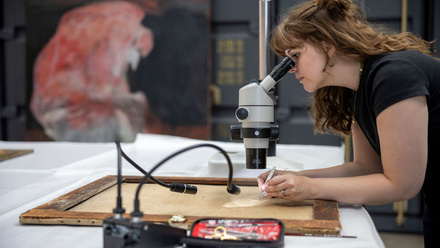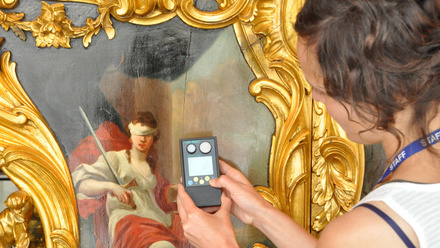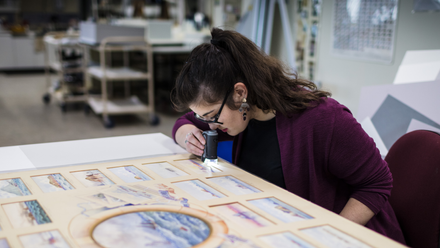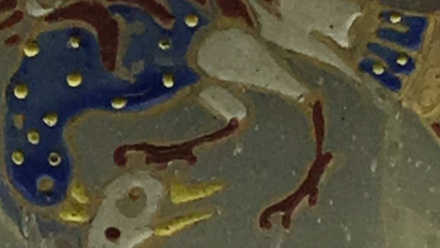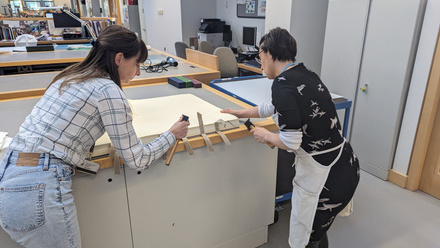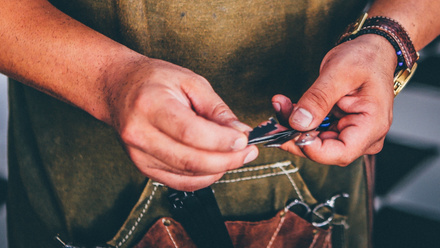Julie Dawson, winner of the 2022 Plowden Medal, was featured in Icon’s membership magazine, Iconnect (Issue 2, April 2023), talking about her work with ancient Egyptian coffins, the benefits of outreach work and improving diversity and inclusion in the cultural heritage industry. Here we share some extra Q&As with Julie that we didn’t have room to publish in the magazine…
Your current research focuses on the reuse of ancient Egyptian coffins. Is this a very early example of sustainability?
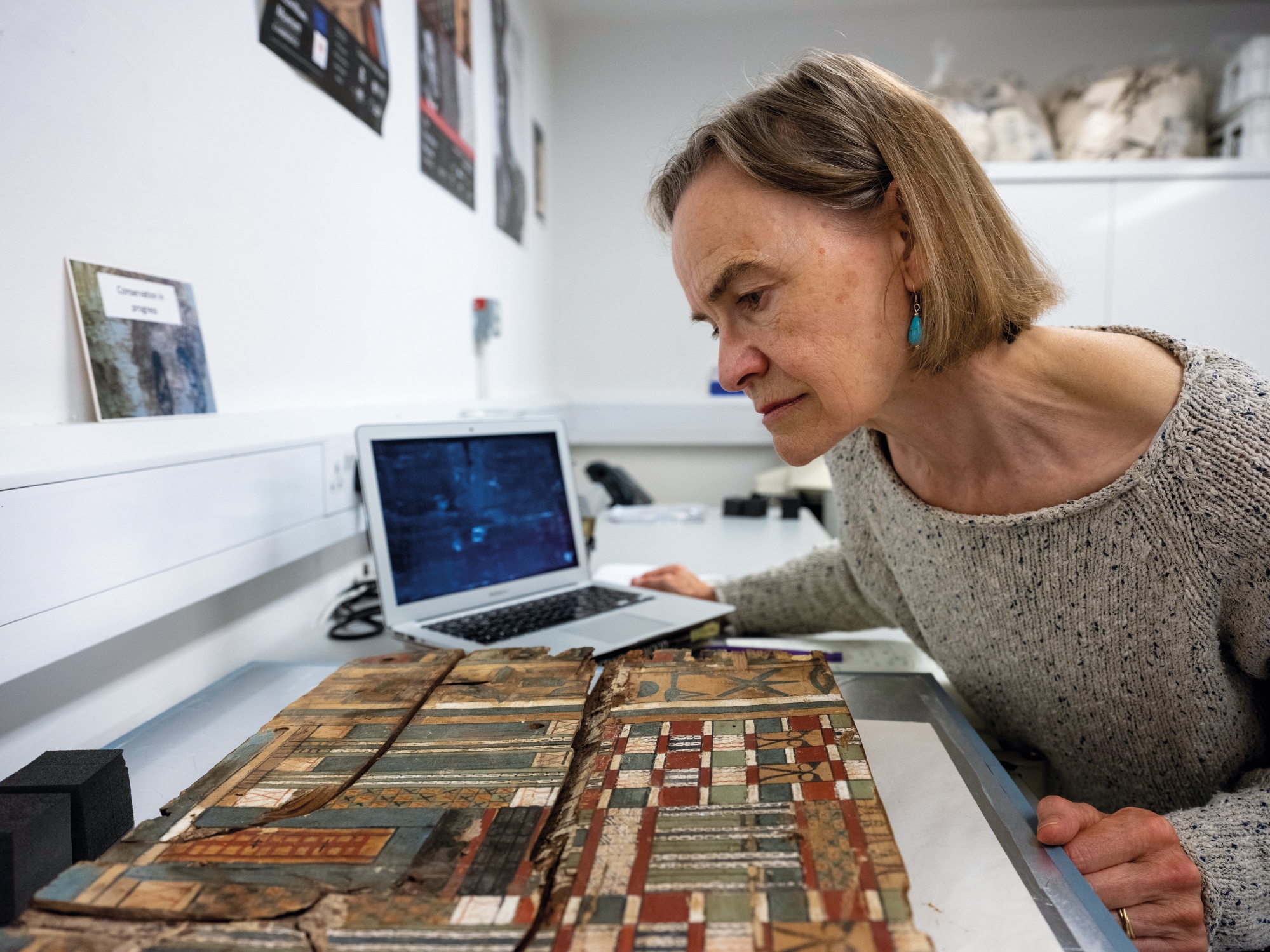
Examining the back panel of the Dynasty 12 (c. 1938 – 1756 BCE) box-shaped coffin of Heta-user (E.67.1903) in August 2022
While we might think this is related to sustainability, it would be an oversimplification to characterise it that way. At the Fitzwilliam Museum, we have found a lot of evidence of recycling of other wooden objects. For example, at the moment we are studying fragments of a Dynasty 12 (c. 1975–1790 BCE) box-shaped coffin of Heta-user (E.67.1903) that we think was probably made from a very large door.
However, from the end of the New Kingdom (c. 1100 BC) onwards, it is certain that complete coffins from older burials were being given a ‘makeover’. As Egypt then entered a period of political and economic instability, numerous tomb robberies were reported and investigated, and there is now considerable physical evidence to indicate that many of the anthropoid coffins created in Luxor during that period were made from wood taken from coffins created 300-500 years earlier.
So, we may be looking at both pragmatic decisions to reuse material – perhaps due to the shortage of good quality wood – but also the opportunistic use of coffins from tombs that were being ransacked for other goods at the time.
How has computed tomography (CT) and microCT scanning of coffins enhanced this understanding in recent years?
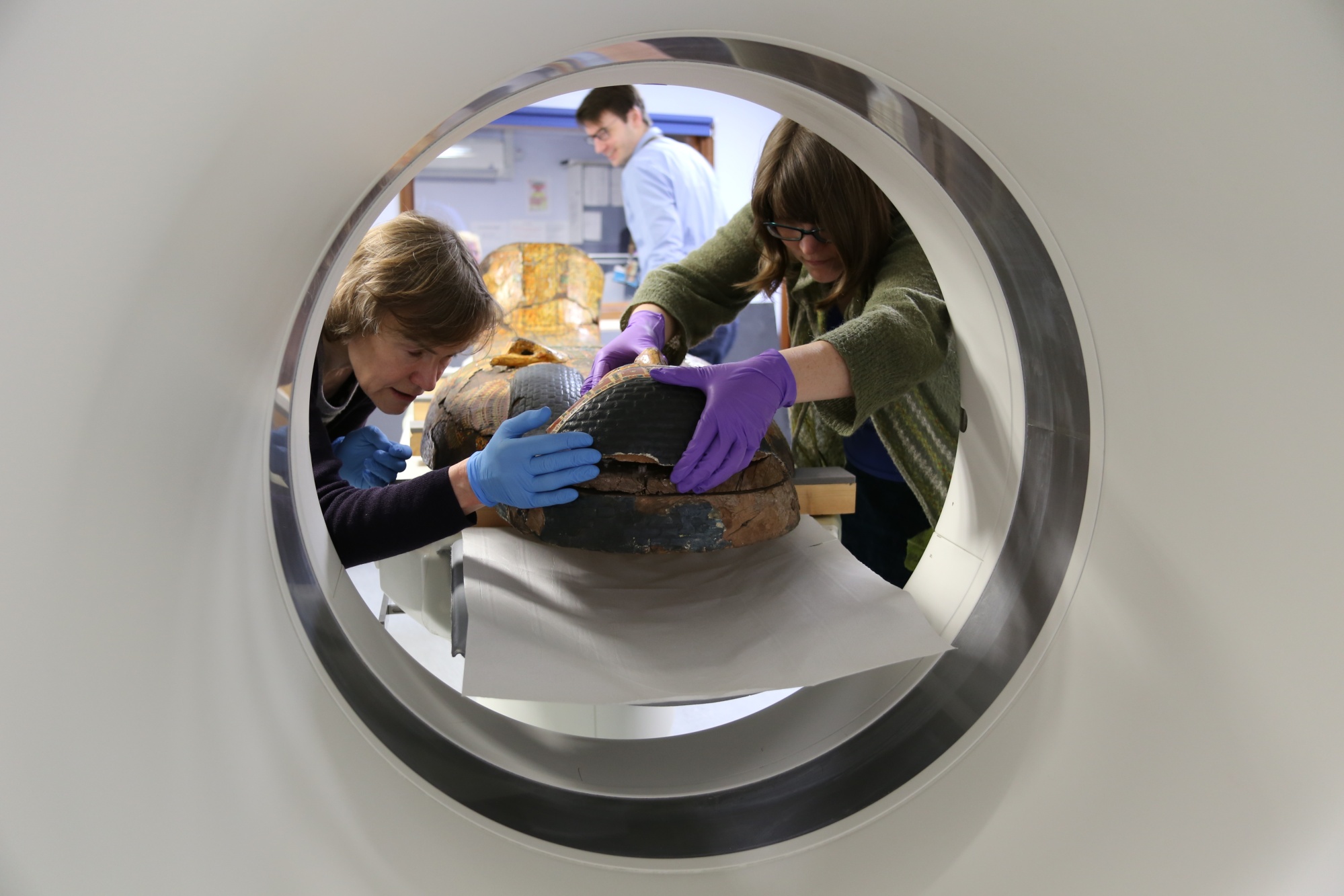
Positioning the inner coffin lid of Nespawershefyt on the gantry of a CT scanner in Addenbrooke’s Hospital, Cambridge, with Fitzwilliam conservator Jenny Marchant (1979–2020) in 2015
These techniques have been used for years in the investigation of mummies but they allow us to interrogate the internal construction of wooden coffins also, to a level that I think is currently unsurpassed. The data is very detailed and can be examined simultaneously in three planes. Once you have an understanding of the individual features, the data can be rendered in different ways to show precisely how the object is structured.
Just one example from our work is the inner coffin of the coffin set of Nespawershefyt (E.1.1822). This dates to about 1000 BCE and, from his job titles written on the coffin and the complexity and quality of the decoration of the coffin set, we know that this man could afford the best. X-radiographs, which we take routinely as one of the first steps of investigation, presented us with very complex images that were hard to disentangle. Through CT work, however, we have been able to interpret the complicated puzzle presented by the woodwork and filler materials, which are hidden under highly accomplished and well-preserved decorative layers. From the many cut-through or redundant joints revealed in the scan images, it seems clear that much of this 21st Dynasty coffin is made of reused wood and that both sides of the coffin box and one side of the lid are made from a dismantled and reshaped coffin that dates from about 500 years earlier.
For images and more information, visit this website.
Can you give us an example of a new technique or innovation you developed for conserving and handling fragile Egyptian coffins?
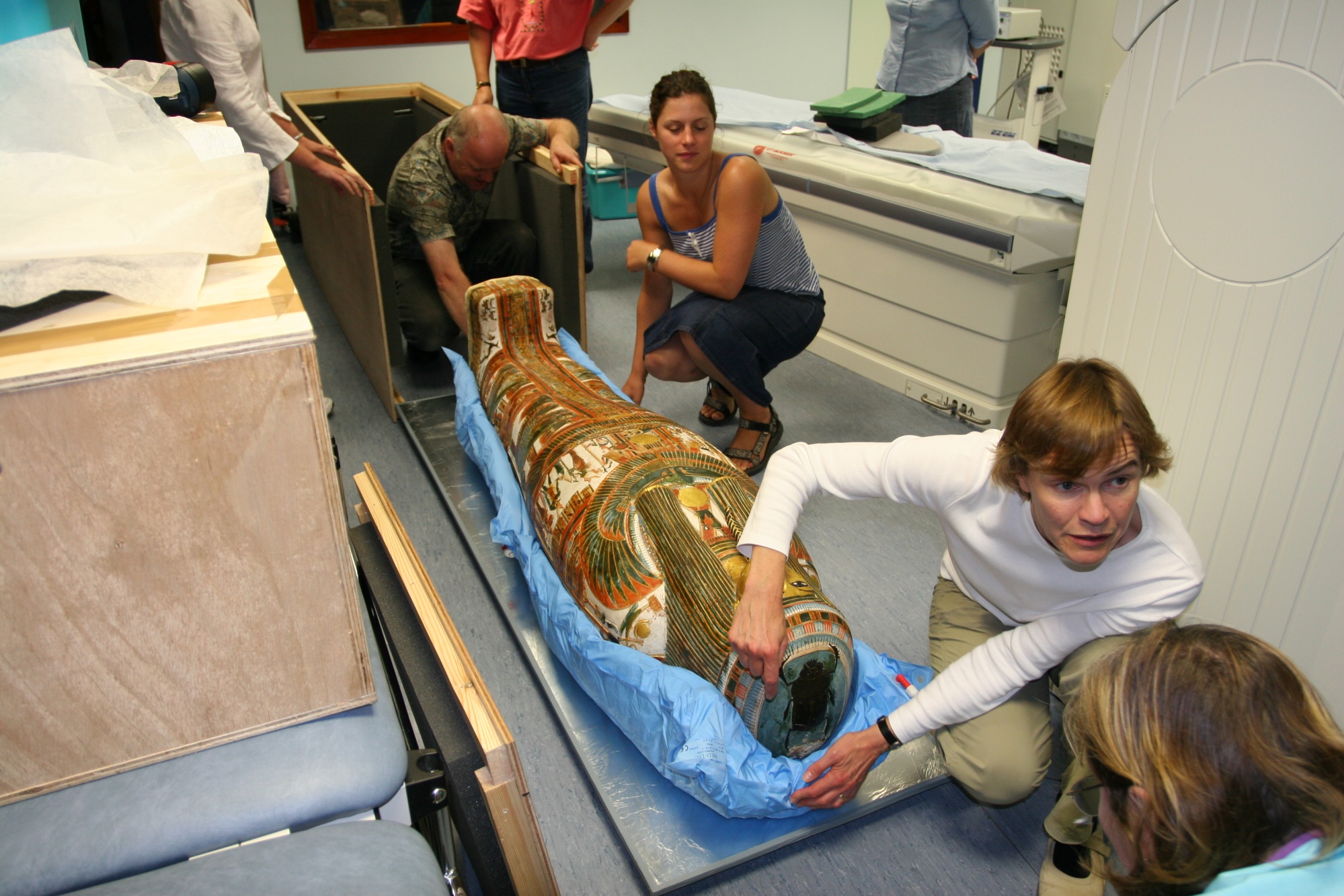
Cartonnage mummy case of Nakhtefmut (E.64.1896) supported on medical vacuum cushions, being slid out of its travelling crate at Addenbrooke’s Hospital in 2006 prior to CT scanning
I think almost anything I could personally claim as an ‘innovation’ has long been overtaken by new techniques and materials! However, I would like to give a renewed shout-out for medical vacuum cushions in case people are not aware of them. I wrote a note about them in Icon News in 2006 after we started using them for immobilising objects during treatment and as a way to make really tailored packing when transporting any large, fragile pieces (not only mummies and coffins). They are brilliant but quite expensive, however the Fitzwilliam is still using the ones we bought 20 years ago.
Tell us a little bit about your efforts to integrate conservation into all aspects of museum work. What are the advantages of taking this integrated approach?
If this approach succeeds, it should ensure that the highest standards of conservation and collections care underpin everything a museum does. Success is also about realising the contribution that our specific skills and expertise can make to a museum’s broader development and outreach activities.
Everyone working in a museum has a responsibility for the well-being of the collection, of which they are generally aware and mindful. But they are also preoccupied by their own priorities, pressures and deadlines. Conservators are the people who have the specific training, expertise and experience in the physical nature and vulnerabilities of the objects. We need to ensure that others understand this and that we get ourselves to the point of visibility where, whatever type of project is under consideration, someone is asking from the very outset, “how can conservation and collections care support this programme or contribute to this story?” We have to think creatively in order to move towards that point. We have to be alert, firm but highly flexible, willing to be involved in anything and everything, and we have to push.
For example, except in conservation-specific shows, it is still rare for a conservator to be at the heart of devising and developing a whole exhibition and to be involved in every aspect including the concept, catalogue, education programme and even the press and marketing decisions. However, my role as co-lead of the Fitzwilliam’s ancient Egyptian coffins exhibition gave me the invaluable opportunity to co-curate the exhibition ‘Death on the Nile: Uncovering the afterlife of ancient Egypt’. This experience was important for me and the other conservators working on the project. It deepened our understanding of the concerns and constraints of specialists in other areas of the Museum and changed the way that I then approached our conservators’ involvement with other major events and shows. It also reinforced how conservators really can be equal partners with other museum professionals in high profile events and bring innovation and enrichment to the experience for visitors.
You have also worked on initiatives to raise collections care awareness and profile in museums in and around Cambridge, at a grassroots level. What have been some of the key areas/issues and which staff members have benefited in particular?
Whilst the importance of having specialist staff must not be diminished, for collections care in particular it is critical to find mechanisms which can best support and give confidence to other museum professionals and volunteers, especially given the constraints of a challenging economic environment. The University of Cambridge Museums consortium (UCM) consists of eight diverse collections, in association also with the University Library and the Botanic Garden. Six of the museums are embedded in University teaching departments and most did not have conservators and had only limited professional collections care support when the consortium came together in 2012. A basic, but key initiative was to form a support network for all colleagues who have direct responsibility for the physical care of collections across these diverse museums, whoever they are and whatever their job titles are, from caretakers to academic staff. Arts Council England NPO funding helped us create a conservation post to boost professional support across those institutions and one conservator, working closely with SHARE Museums East, dedicated to collections care support for the regional museums. Through working together on key areas such as emergency response, building up physical and online resources, offering small equipment and CPD grants, creating regular training events and making creative use of placement opportunities we have tried to make something sustainable and cost-effective for UCM. A new model is currently in development, but the essential elements of the support network remain in place.
Tell us about the knowledge-transfer project you co-led between the Fitzwilliam Museum and the Egyptian Museum, Cairo?
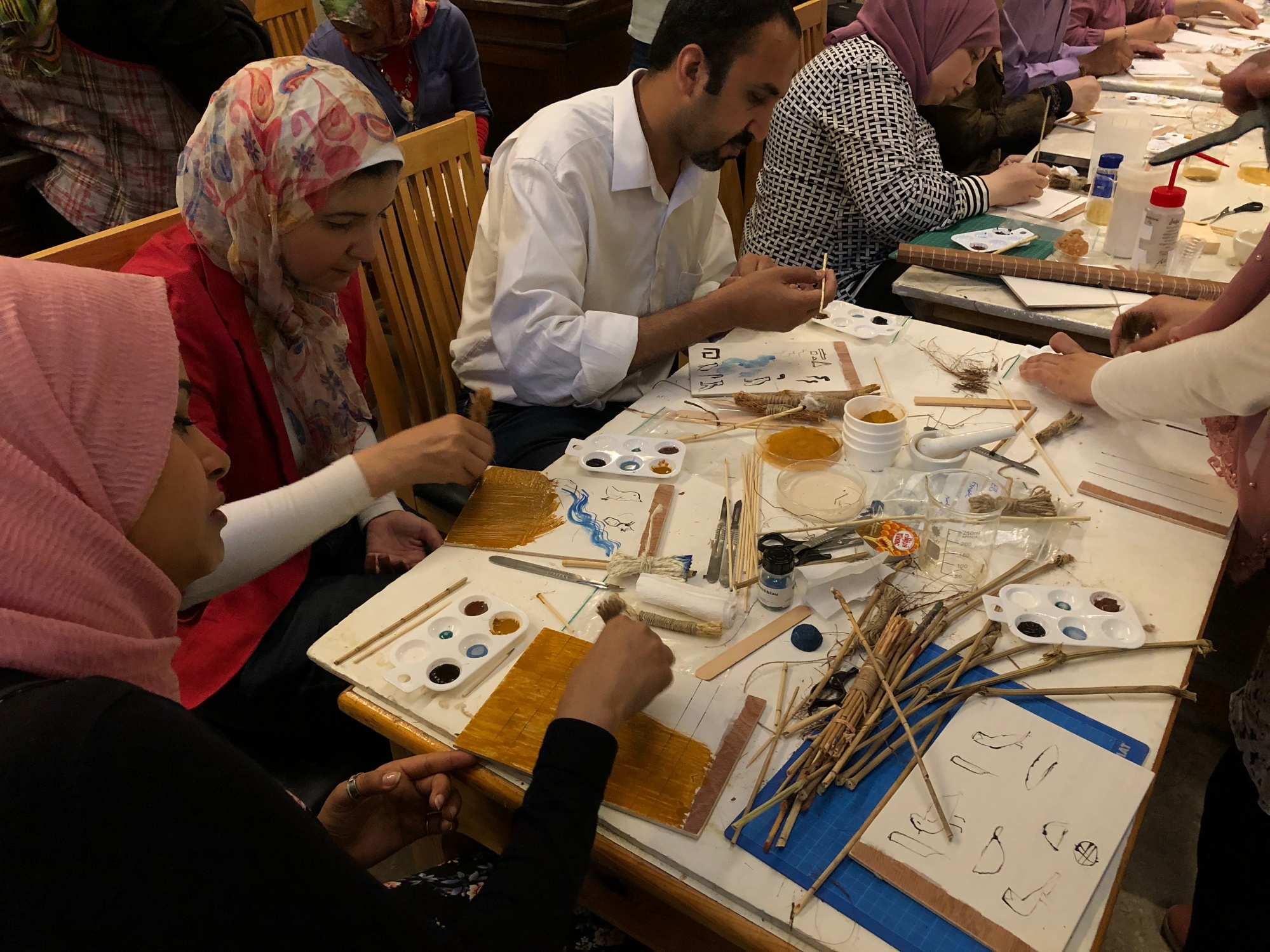
Workshop participants in the Egyptian Museum Cairo in June 2019 trying out the reed pens and fibre brushes that they had made
This arose from conversations with the Director, curators, conservators and scientists at the Egyptian Museum Cairo (EMC) about the documentation, research and conservation project that they were undertaking on coffins in their collections. They were interested in the multi-disciplinary methodology of our approach at the Fitzwilliam and so we considered how we might work together to share collections’ knowledge and experience.
We identified potential resources and practical training opportunities and then set out to deliver a programme which was funded by two grants from the UK’s Global Challenges Research Fund. A key element was a four-day workshop in Cairo in 2019, on coffin construction and decoration, developed from a workshop that we had created to precede our conference ‘Ancient Egyptian Coffins - Past, Present, Future’ in Cambridge in 2016.
The workshop explored curatorial approaches and methods of imaging and analysis, but also focused on recognising and understanding the original technologies of manufacture, and the importance of this to interpretation of the objects’ history and context. Together, we examined coffins in the EMC collection. Through lectures and demonstrations, we looked at carpentry techniques, the making and using of grounds, paint, brushes and reed pens, and experimented with application of the pistacia resin varnish that is a feature of many coffins. The participants then had plenty of opportunity to try out all these processes themselves.
We were asked to repeat the workshop with museum professionals and academics in Alexandria later in the year, and this time our aim was for participants from the Cairo sessions to build in additional examples and teaching materials from their own coffins’ research. The Cambridge and Cairo teams then co-delivered the workshop in Alexandria, thus moving a little closer to our principal focus of establishing an Egyptian peer-to-peer training network for curators and conservators.
A number of your projects and workshops have included a practical element, where the public or delegates can try out the materials, tools and techniques used by ancient Egyptians to build coffins. What are the benefits of offering hands-on experiences like this?
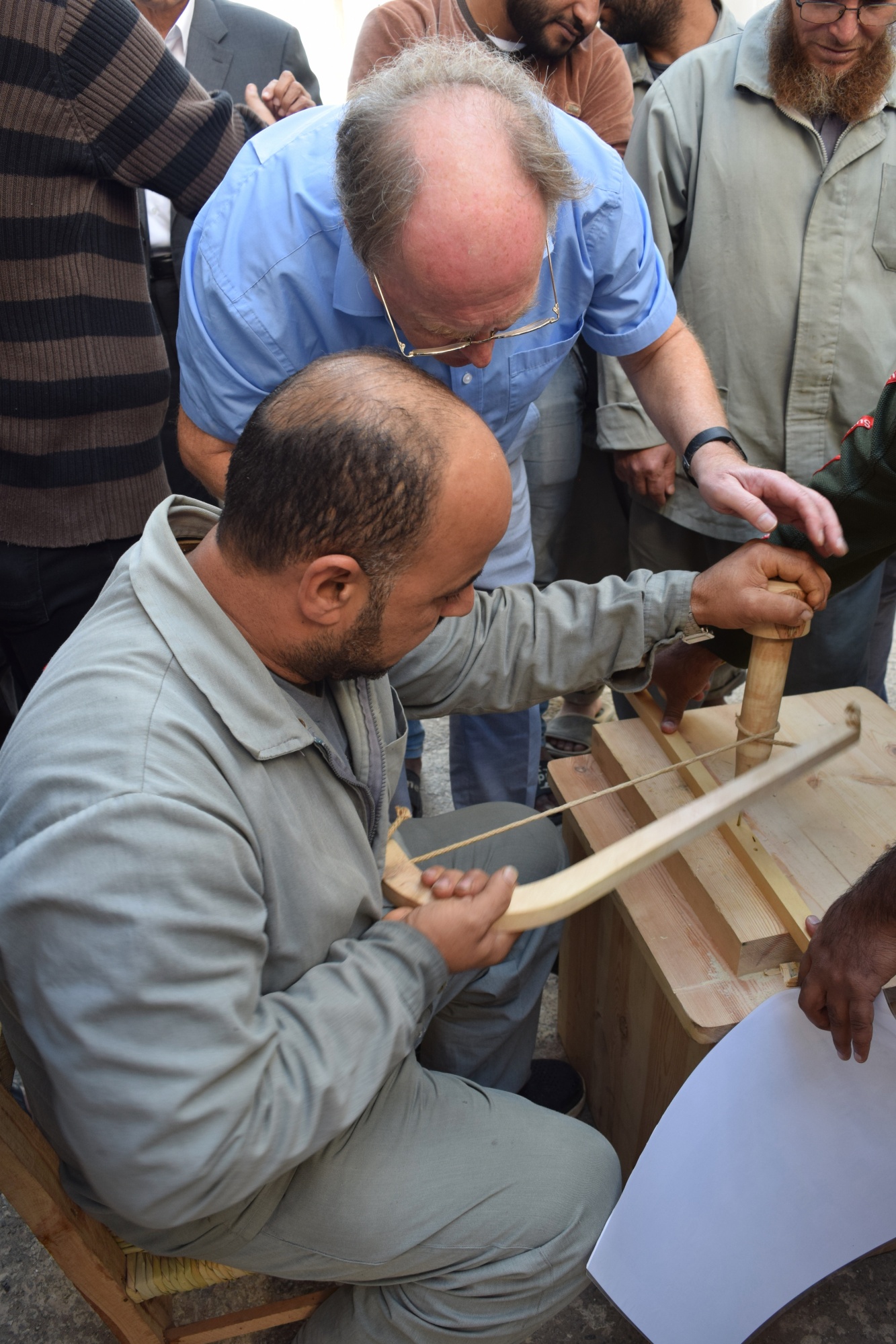
Picture credit: Lorraine March-Killen. A carpenter at the Pinnochio furniture factory in Damietta, Egypt, tries out a replica bow drill, watched by Dr Geoffrey Killen, specialist in ancient Egyptian woodworking and member of the Coffins Project and ‘pop-up’ team
It is important, of course, that these hands-on elements are built on as much hard evidence of materials, practice and context as we can muster. Also, I understand very well that we can never really put ourselves into the situation and mindset of the ancient craftsman or the person who commissioned the work. But there is a world of difference between knowing what the methods of making are and actually doing these for yourself and relating this back to the tool marks and other manufacturing information you see on an object. Gaining even a basic experience of the practical processes of creating and decorating helps us interpret the evidence, and that is as true for the public as it is for us, so, yes - I would always try to build in a hands-on session, whether we are doing something for a specialist or a non-specialist audience.
In the public context, as we found in the ‘pop-ups’, these sorts of activity can also help people find ways into cultures, objects and research that may otherwise feel a bit inaccessible. They can provide a bridge from someone’s knowledge and experience of, for example, trades and hobbies such as carpentry and painting, to the skills of the Egyptians and how these fitted into other aspects of those ancient lives - including the all-important preparation for death and an afterlife. Inevitably, our conversations very often led also to questions about the fragility, longevity and survival of the coffins and how we protect and conserve these precious items.
In the coffins’ exhibition, we couldn’t offer these types of activities in the display galleries. But we had a lot of information about how we investigated the coffins, examples from our replication experiments and materials to handle.
Some of this was integrated into the presentation of individual coffins and some was clustered around a space in the exhibition where conservation of coffin parts was taking place. In the feedback from visitors, this space and activity and the chance to speak with the conservator was very often cited as the highlight of the show. People are always attracted and fascinated by the work and I think that, in this case, its complete integration into the Egyptological and scientific and technical research helped cement its critical role in the story. You don’t get much conservation done but the trade-off is definitely worth it!
What key qualities and skills do you think need to be encouraged in the next generation of conservators, or those wishing to progress in their career?
It is important to continue to value the qualities we have always needed, such as critical thinking, a strong commitment to ethical practice, curiosity, excellent hand skills, ingenuity, patience, flexibility, willingness to collaborate, and the ability to understand the needs of others in relation to the objects you care for.
Conservation is one of the most important issues of our time; conservation of nature and natural resources, but also heritage conservation. We are a huge part of the story: developing and maintaining confidence in the value and importance of what you as a conservator can do for society is critical to your own progress and that of the profession overall.
Conservators these days are expected to do a huge range of activities beyond technical investigation, treatment work at the bench and collections care. They need to engage with strategy and large-scale planning, fund-raising, advocacy and public engagement. They also have to navigate the complex issues of the day - sustainability, diversity and inclusion, restitution and repatriation, to name just a few - and specifically as these impact on the care of cultural heritage. It’s a complex landscape, but there is now a myriad of resources supplied by the professional bodies, here and abroad, and a vibrant community with which to engage
Finally, a close colleague of yours happened to mention your cake decorating skills – tell us about your favourite Egyptian-themed bake…
I’ve made quite a few cakes based on Fitzwilliam objects, but my favourite was the coffin of Userhet (E.88.1903), which I made after our coffins’ exhibition in 2016. How could I resist that challenge? I am quite tempted now to make a cake of the beautiful, newly designed Plowden Medal that sits in my house.
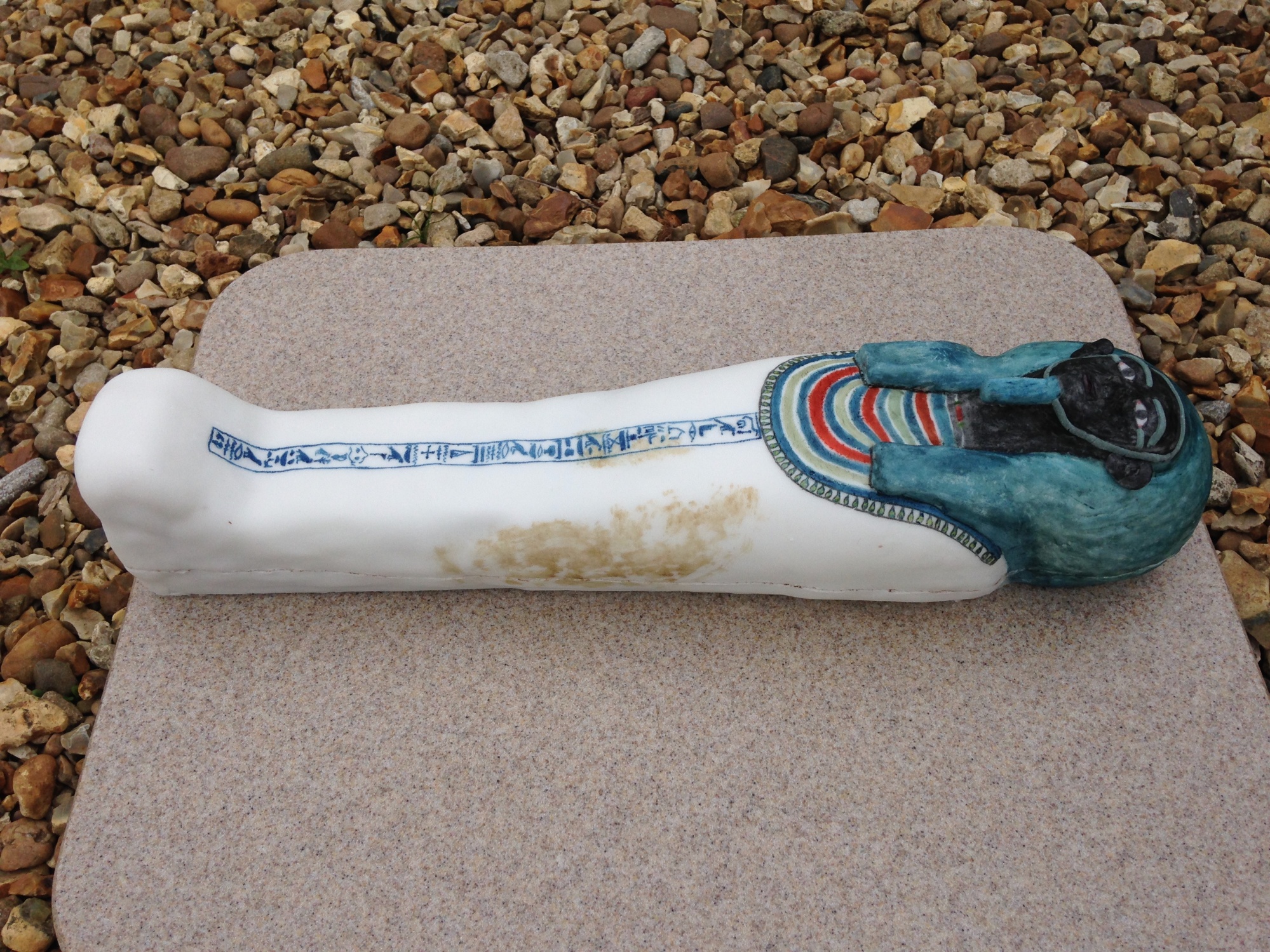
About Julie
Julie Dawson is an archaeological conservator, former Head of Conservation and Scientific Research at the Fitzwilliam Museum, Cambridge and lead of the University of Cambridge Museums Conservation and Collections Care Group, before her retirement in May 2021. Alongside Helen Strudwick, she was the co-lead of the Egyptian Coffins Project, from 2014. In 2021, Julie was awarded a Leverhulme Emeritus Fellowship for two years to continue her research on Egyptian coffins. She is now an Affiliated Researcher at the Fitzwilliam. www.egyptiancoffins.org
Read Julie's full interview in the second issue of Iconnect Magazine.

